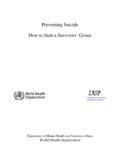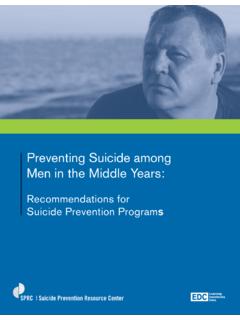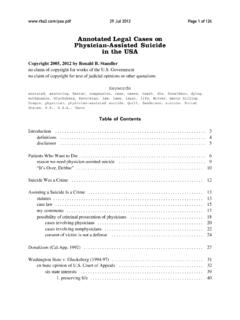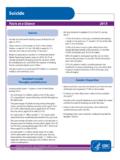Transcription of Preventing Suicide A Resource for Media Professionals
1 Preventing Suicide A Resource for Media Professionals Department of Mental Health and Substance Abuse World Health Organization International Associationfor Suicide PreventionInternational Associationfor Suicide PreventionWHO Library Cataloguing-in-Publication Data Preventing Suicide : a Resource for Media Professionals . - prevention and control. , Attempted - prevention and control. Media . services. Health Organization. Dept. of Mental Health and Substance Abuse. Association for Suicide Prevention. ISBN 978 92 4 159707 4 (NLM classification: HV 6545) World Health Organization 2008 All rights reserved. Publications of the World Health Organization can be obtained from WHO Press, World Health Organization, 20 Avenue Appia, 1211 Geneva 27, Switzerland (tel.)
2 : +41 22 791 3264; fax: +41 22 791 4857; e-mail: Requests for permission to reproduce or translate WHO publications whether for sale or for noncommercial distribution should be addressed to WHO Press, at the above address (fax: +41 22 791 4806; e-mail: The designations employed and the presentation of the material in this publication do not imply the expression of any opinion whatsoever on the part of the World Health Organization concerning the legal status of any country, territory, city or area or of its authorities, or concerning the delimitation of its frontiers or boundaries. Dotted lines on maps represent approximate border lines for which there may not yet be full agreement.)
3 The mention of specific companies or of certain manufacturers products does not imply that they are endorsed or recommended by the World Health Organization in preference to others of a similar nature that are not mentioned. Errors and omissions excepted, the names of proprietary products are distinguished by initial capital letters. All reasonable precautions have been taken by the World Health Organization to verify the information contained in this publication. However, the published material is being distributed without warranty of any kind, either expressed or implied. The responsibility for the interpretation and use of the material lies with the reader. In no event shall the World Health Organization be liable for damages arising from its use.
4 Printed by the WHO Document Production Services, Geneva, Switzerland CONTENTS 1 Quick reference for Media Professionals .. 3 Introduction .. 5 Evidence for imitation .. 6 Responsible reporting .. 7 Take the opportunity to educate the public about 7 Avoid language which sensationalizes or normalizes Suicide , or presents it as a solution to 7 Avoid prominent placement and undue repetition of stories about 8 Avoid explicit description of the method used in a completed or attempted 8 Avoid providing detailed information about the site of a completed or attempted 9 Word headlines 9 Exercise caution in using photographs or video 9 Take particular care in reporting celebrity 10 Show due consideration for people bereaved by 10 Provide information about where to seek 10 Recognize that Media Professionals themselves may be affected by stories about 11 Sources of reliable information.
5 11 Other forms of 12 Annex 1: An overview of the scientific literature on imitation .. 13 References .. 16 1 FOREWORD Suicide is a serious public health problem that demands our attention, but its prevention and control, unfortunately, are no easy task. State-of-the-art research indicates that the prevention of Suicide , while feasible, involves a whole series of activities, ranging from the provision of the best possible conditions for bringing up our children and youth, through the effective treatment of mental disorders, to the environmental control of risk factors. Appropriate dissemination of information and awareness-raising are essential elements in the success of Suicide prevention programmes.
6 In 1999 WHO launched SUPRE, its worldwide initiative for the prevention of Suicide . This booklet is the revised version of one of a series of resources prepared as part of SUPRE which are addressed to specific social and professional groups that are particularly relevant to the prevention of Suicide . The revised booklet is the product of a continuing collaboration between WHO and the International Association for Suicide Prevention (IASP). It represents a link in a long and diversified chain involving a wide range of people and groups, including health Professionals , educators, social agencies, governments, legislators, social communicators, law enforcers, families and communities.
7 We are particularly indebted to Professor Diego de Leo, Griffith University, Brisbane, Queensland, Australia, who produced an earlier version of this booklet. Our gratitude also goes to Dr Lakshmi Vijayakumar, SNEHA, Chennai, India, for her assistance in the technical editing. The text was reviewed by the following members of the WHO International Network for Suicide Prevention, to whom we are grateful: Dr Sergio P rez Barrero, Hospital de Bayamo, Granma, Cuba Dr Annette Beautrais, Christchurch School of Medicine, Christchurch, New Zealand Dr Ahmed Okasha, Ain Shams University, Cairo, Egypt Professor Lourens Schlebusch, University of Natal, Durban, South Africa Professor Jean-Pierre Soubrier, Groupe Hospitalier Cochin, Paris, France Dr Airi V rnik, Tartu University, Tallinn, Estonia Professor Danuta Wasserman, National Centre for Suicide Research and Control, Stockholm, Sweden Dr Shutao Zhai, Nanjing Medical University Brain Hospital, Nanjing, China.
8 The current update and revision of this booklet has been undertaken by the Media Task Force of IASP. We would like to thank the following persons for their contributions to the updated and revised version: Associate Professor Jane Pirkis, School of Population Health, University of Melbourne, Melbourne, Australia Mr Karl Andriessen, Suicide Prevention Project of the Flemish Mental Health Centres, Gent, Belgium 2 Ms Jane Arigho, Headline, Dublin, Ireland Dr Loraine Barnaby, Department of Community Health and Psychiatry, University of the West Indies, Mona, Jamaica Associate Professor Annette Beautrais, Canterbury Suicide Project, Christchurch School of Medicine and Health Sciences, University of Otago, Christchurch, New Zealand Professor R Warwick Blood, School of Professional Communication, University of Canberra, Canberra.
9 Australia Professor Thomas Bronisch, Max-Planck-Institute of Psychiatry, Munich, Germany Dr Sunny Collings, Social Psychiatry and Population Mental Health Research Unit, University of Otago, Wellington School of Medicine and Health Sciences, Christchurch, New Zealand Dr John Connolly, Irish Association of Suicidology, Dublin, Ireland Mr Nico De fauw, Flemish Working Group on Suicide Survivors, Gent, Belgium Dr Elmar Etzersdorfer, Furtbachkrankenhaus, Klinik f r Psychiatrie und Psychotherapie, Stuttgart, Germany Mr King-wa Fu, Centre for Suicide Research and Prevention, University of Hong Kong, China, Hong Kong SAR Dr Gururaj Gopalakrishna, National Institute of Mental Health and Neurosciences, Bangalore, India Professor Keith Hawton, Centre for Suicide Research, Oxford University, Oxford, United Kingdom Dr Henning Herrestad, Suicide Research and Prevention Unit, University of Oslo, Oslo, Norway Dr Karolina Krysinska, School of Medicine, University of Queensland, Brisbane, Australia Ms Ann Luce, Cardiff University, Cardiff, United Kingdom Dr Thomas Niederkrotenthaler, Institute of Medical Psychology, Center for Public Health, Medical University of Vienna, Vienna, Austria Dr Paul Yip, Centre for Suicide Research and Prevention.
10 University of Hong Kong, China, Hong Kong SAR. The collaboration of IASP with WHO on its activities related to Suicide prevention is greatly appreciated. The resources are being widely disseminated, in the hope that they will be translated and adapted to local conditions - a prerequisite for their effectiveness. Comments and requests for permission to translate and adapt them will be welcome. Alexandra Fleischmann, Scientist Brian L Mishara Jos M Bertolote, Coordinator President Management of Mental and Brain Disorders International Association Department of Mental Health and Substance Abuse for Suicide Prevention 3 Quick reference for Media Professionals Take the opportunity to educate the public about Suicide Avoid language which sensationalizes or normalizes Suicide .
















